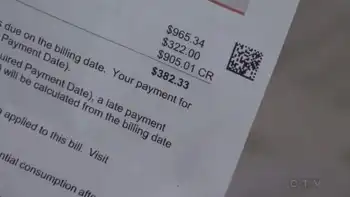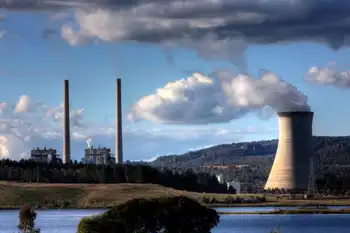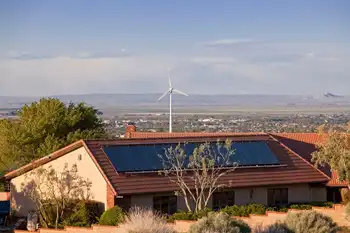Green dies hard
By Financial Post
NFPA 70b Training - Electrical Maintenance
Our customized live online or in‑person group training can be delivered to your staff at your location.

- Live Online
- 12 hours Instructor-led
- Group Training Available
The logic is easy enough to follow. Petroleum is cheap once again, having plummeted from (US)$147 a barrel in July to (US)$47 as of mid-March — greatly reducing the incentive for fuel efficiency. Across the United States and Canada, meanwhile, four million people have been thrown out of work by the recession. Investors have seen close to 25% of their life savings go down the tubes. Housing prices have crashed.
Times are tough, in other words, and chances are you're more concerned with making ends meet than you are with saving the planet. Paying a little extra for concentrated laundry detergent doesn't sound like such a good idea anymore. Neither does investing in that speculative biofuels start-up. And that letter you'd meant to send to your local MP demanding that more tax dollars be spent saving trees — well, suddenly, that doesn't seem so prudent.
Lack of consumer demand, lack of investment dollars, lack of political will — all this would spell doom for the environmental cause. But news of the green movement's death has been exaggerated. For close to 50 years, modern environmentalism has inched along, taking two steps forward and — when economic disruptions grab our attention — one step back.
Since the turn of the century, however, a remarkable thing has happened. Beyond merely attaining a new level of awareness, environmentalism has reached a tipping point, going from subculture to common culture, manifesting itself in the products we buy, the politicians we elect and the priorities we hold dear. Skeptics will argue that public interest in the environment is fickle, dependent only on fair-weather economic factors.
Remember the SUV craze of the late '90s? North Americans, having survived a housing crash and a deep recession, were looking to splurge, and cheap gasoline offered more enticement. So it's no surprise that many of us went out and bought the biggest, meanest ute we could find. Given the right conditions, they argue, we'll do it again.
True, oil is cheap once more, a recession has robbed us of our financial security, and real estate is crashing. But this time, history will not be repeating itself. It's time again to utter those most naïve of words — "this time it's different" — because this time it is.
To call environmentalism a mere "movement" today is to underestimate the hold it has over us. Sustainability is no longer a sphere dominated by activists and special interests; it can be found in every aspect of our lives, whether in curbside recycling programs or corporate initiatives or political speeches. Today, green is mainstream, and nothing — not the recession or cheap oil or resurgent consumerism - is going to stop it. Here's why.
"If you told me five years ago that I'd be standing here tonight, speaking to a room full of environmentalists, I'd have said you were crazy." That quote — uttered last November by Royal Bank CEO Gordon Nixon at a gala dinner held by Pollution Probe, an environmental NGO — illustrates the kind of metamorphosis corporations in North America have undergone over the past decade.
Not so long ago, the debate over environmental policy held no place for corporate leaders, unless the companies they led were the most egregious polluters. Now everything has changed. As sustainability embeds itself in the public consciousness, pressure from all sides — customers, shareholders, government, even employees — has forced all kinds of companies to go green. According to a study released in February by Info-Tech Research Group, 17% of corporations reported green programs in place, while another 56% were planning them for 2009, despite the economic downturn.
These green programs fall under the main categories of waste and energy reduction, recycling and sustainable sourcing. Bell Canada, for instance, has had a recycling program in place since 2003 that has diverted 500,000 cellphones from landfill. Meanwhile, Cisco Canada, which specializes in teleconferencing solutions, has placed a ban on corporate travel.
The most evident response can be seen in the retail sector, which engages with consumers on a daily basis. Today you can watch TV ads where Galen Weston Jr. — CEO of Loblaws and heir to Canada's third-largest fortune — earnestly pitches green products. Walk into any Wal-Mart, meanwhile, and you'll find recycling bins everywhere and the company's "For the Greener Good" logo plastered on hundreds of "green-certified" items — light bulbs, baby food, even flat-panel TVs.
Wal-Mart's marketing campaign is just the tip of the iceberg. Behind the scenes, a top-to-bottom review of its operations — including the efficiency of its buildings, trucking fleet and logistical systems — has resulted in hundreds of millions in savings, offering a crucial bottom-line incentive for shareholders. The company's obsession with cutting costs even influences its suppliers, as Wal-Mart's 70,000 vendors are required to "green" their products in order to gain access to shelves at over 7,500 outlets.
Creating and managing these sorts of programs has come under the purview of a new breed of sustainability professional, which even extends into the executive ranks. In November 2007, for instance, Royal Bank instituted a "corporate citizenship office," along with a new executive-level position, held by Shari Austin, vice-president of corporate citizenship. Austin leads a team of 10 at RBC, including three environmental engineers, who monitor the bank's carbon emissions and report progress on reductions.
Demand for such expertise, meanwhile, has led MBA programs across the country to offer sustainability as a subject. Rob Klassen, a professor at the Ivey School of Business, says that the need for sustainability training has skyrocketed in recent years — an observation supported by stats from the Carbon Disclosure Project, an agency tasked with developing standards for emissions reporting. According to the CDP, 73% of S&P 500 companies reported their emissions in 2008, a jump from about 40% in 2005.
As the recession deepens, however, Klassen acknowledges that employment positions related to sustainability will be in jeopardy. "I think those are the people at most risk in the short term." That being said, he views it as a temporary pullback.
RBC's Austin, for her part, doesn't see a retrenchment coming any time soon, and points to external pressures that will keep companies in check. "We have a whole slate of indices and rating organizations that are going over us with a fine-toothed comb." Some of these include the Jantzi Social Index; Innovest's 100 Most Sustainable Corporations in the World ranking; and the Dow Jones World Sustainability Index.
Getting on these benchmark rankings is crucial if companies like Royal Bank are to access the billions of dollars under management at pension funds like the CPP Investment Board. In 2005, the board, which manages $110 billion in Canadian pension assets, issued its "Policy on Responsible Investing," which stated that it "will use its ownership positions in over 2,600 companies to encourage improved performance on and disclosure of environmental, social and governance factors."
The bottom line is, there's been a fundamental shift in consciousness at corporations over the past few years. The recession may push environmental stories off the front page for a while, and green projects may be delayed or watered down - but corporations are not about to put their programs on ice. As Austin puts it, "There's no going back to where we were a few years ago."
About one quarter of all greenhouse-gas emissions in North America comes from auto-mobiles, and while we'd like to think that technology has made the average vehicle more fuel efficient, the truth is that our love affair with Jeeps and SUVs has more than negated any advances in fuel efficiency.
According to the U.S. Environmental Protection Agency (EPA), fuel efficiency for new cars first peaked around 1987 — that's right, 22 years ago — at 26.2 miles per gallon. Since then, average efficiency has fallen as consumers opted for what the industry refers to as "light trucks." The trend only started to reverse itself again in 2005, as skyrocketing gas prices lured consumers to ultra-efficient Japanese hybrids. So now that oil has crashed back down to earth, what's to prevent us from falling back into old habits? Simple: Auto emission standards.
The fact is, regardless of the mood of consumers or the price of gasoline, stringent standards for automotive fuel efficiency have already been set. In 2007, the U.S. government passed corporate average fuel economy (CAFE) targets that will require automakers to sell vehicles that average 35 mpg by 2020 — a 40% increase from today's average of 25 mpg.
Past recessions might have offered automakers a reprieve from such onerous regulations. But having already received close (US)$30 billion in bailout loans from government, automakers are long past using bankruptcy as a threat. Indeed, if a little back-and-forth correspondence between California governor Arnold Schwarzenegger and new president Barack Obama is any indication, there's reason to believe the new CAFE standards may actually be raised.
Soon after Obama took office, Schwarzenegger sent a letter asking Obama to reopen discussions on whether his state, along with 16 others — representing 40% of the U.S. population — might impose even more stringent standards, forcing automakers to reach 42 mpg by 2020. "Your administration," Schwarzenegger wrote in the letter, "has a unique opportunity to move America toward global leadership on addressing climate change."
In January, in a move that caught automakers by surprise, Obama complied with the request, ordering the EPA to reconsider an earlier Bush administration decision to deny California's proposal. Automotive analyst Paul Lacy, at IHS Global Insight, says that tougher standards would be a disaster for the automakers, and he doesn't see them as being viable. Indeed, industry estimates peg the cost of reaching 40 mpg at around (US)$5,000 per vehicle, and Lacy figures that customers simply won't be willing to pay that.
But Lacy also acknowledges that what consumers are individually willing to pay for isn't as important as whom they're collectively willing to vote for - and they're voting for standard setters. As long as those CAFE standards remain in place, automakers simply won't be allowed to sell larger vehicles, unless they're efficient.
In fact, making big cars that people love — but that also sip fuel — will be the ultimate test for the automakers, and they've made great strides already by upgrading popular light trucks with hybrid drive trains. In 2008, for example, GM's Chevy Tahoe Hybrid, an SUV, was named "Green Car of the Year" by Green Car Journal. Ford, meanwhile, is looking to increase the efficiency of its popular F150 pickup by reducing its size and using lighter materials, while maintaining its structural integrity.
But whatever the future holds — whether it's expensive trucks with advanced technology or smaller cars with today's efficient engines — the days of the gas guzzler are numbered.
The business argument for environmentalism has, until recently, been suspect. Green alternatives have been around for decades — electric cars, wind power generation - but they've invariably been more expensive, less convenient and less marketable. As such, investors have seen little reason to back these projects.
Things are changing, though. Modern materials have led to the development of larger and more efficient wind turbines that, in states like Texas and Colorado, generate electricity for less than the price of conventional gas-fired plants. In the solar sector, meanwhile, mass manufacturing techniques have reduced the cost of producing a solar module to below US$1 per watt - one-sixth what it would have cost in 1995.
As investors come to realize that "cleantech" companies — those in renewable energy, waste management, pollution control and energy efficiency — have a profitable future, venture-cap funding has flooded into the sector. According to Thomson Reuters, the average venture-cap investment in late-stage cleantech was about (US)$10 million in 2004. In the first eight months of 2008, the average investment had climbed to (US)$40 million.
The prospect of commercial viability has, in addition, seeded a new organizational infrastructure. Today, any company with the money and inclination can, in theory, become carbon neutral by purchasing carbon credits or "offsets," or by buying renewable energy from a company like Bullfrog Power, which sells electricity sourced from local wind farms and low-impact hydro projects to homes and businesses in Alberta and Ontario.
Tom Heintzman, CEO of Bullfrog, says that, while wind power still sells for a 25% premium in Canada, it hasn't stopped his company from expanding rapidly. Last year, Bullfrog's customer base nearly doubled, to 8,000 homes and 800 businesses, such as Wal-Mart and Royal Bank. And while Heintzman foresees a slowdown at his firm, he won't be issuing layoffs anytime soon.
The future of cleantech looks even brighter. In California and Ontario, a "smart electrical grid" — which will use sophisticated software that puts electrical nodes in constant communication, thereby plugging significant leaks in the system — is already taking shape. In Ontario, in fact, the project is seen as such a priority that the province's recently passed Green Energy Act allocates $1.6 billion to its development.
As the smart grid evolves, Heintzman also envisions "vehicle-to-grid" interconnectivity, where the batteries in our electric cars are used to store excess capacity when electricity is cheap, and supply the grid when it's expensive. If he's right about the opportunities, cleantech will not only survive the recession; it may become one of the driving economic sectors in the first half of this century.
As the recession grinds on and news begins to surface of friends and coworkers who've been laid off, it's hard to see how the environment can remain a priority. But any one fearful that the recession will erase sustainability as a public priority should take a deep breath and remind themselves that, while the recession is forecast to last a year or two, support for environmental issues has been growing for decades, and it's never been as strong as it is today.
One Environics study, subtitled "Is the environment dead as a public issue now that we are in a recession?" found that 57% of Canadians in October — even as their life savings were going over a cliff — said they were definitely, if not extremely, concerned about climate change, essentially unchanged over the previous 12 months. Moreover, the report found that 63% of Canadians wanted the federal government to maintain equal priority on both the economy and the environment, while only 31% wanted the government to focus primarily on economic security until the crisis settles down.
Peter Robinson, chief executive of the David Suzuki Foundation, has watched environmentalism evolve for over 30 years. Before landing at the foundation, he was CEO of Vancouver-based Mountain Equipment Co-Op, a leading supplier of outdoor equipment and clothing. With one foot planted in business and the other in the activist sphere, he's been well situated to witness the peaks and valleys of the movement's popularity.
Robinson says that when an economic disruption occurs, such as the recent recession, consumers tend to move away from their environmental principles temporarily. "But from my perspective," he says, "they never completely reset. There's always a new plateau that's reached, a new level of understanding."
The most recent "plateau" has been groundbreaking, however, because it marks a shift towards true populism. "For decades, environmentalism was pretty devoid of people," he says. "It was all about stopping loggers and miners and keeping wild areas pristine. But if you look at the current phase of the movement, you'll see that it's much more concerned with how people live their lives."
Sustainability initiatives today can be found everywhere. They're where you work, where you shop, in your home. According to a report by Statistics Canada published in December, 45% of Canadians consider themselves environmentally active: 30% compost organic waste; 56% use low-flow shower heads; 59% use CFL bulbs; and 97% of Canadians recycle to some extent — an act that, for most of us, has become second nature.
At the root of all this public activism is a burgeoning awareness that the stakes have been raised. In the past, natural disasters, such as the floods following Hurricane Katrina or the recent Australian wildfires, might have been blamed on Mother Nature alone. But today the public is linking those events to climate change. "The average citizen can't help but make that connection," says Robinson. Beyond consumer preference or economic factors, it's the threat of cataclysmic disaster, he says, that will keep us vigilant.
Robinson isn't saying that the green movement will be immune to the recession. Of course not. If you're struggling to keep up with your mortgage payments, paying a premium for the greenest car on the planet might not be your highest priority, especially if oil prices stay low. The longer the recession lasts, the harder it will be for consumers to continue to sacrifice to make sustainable choices.
The key question, however, is this: How superficial is our interest in the environment? Robinson, for one, doesn't expect Canadians to forgo their green ethics so easily. Decades of advocacy work, he says, have laid the groundwork for a shift that, in the past few years, has finally sunk into the public consciousness. There's no going back now, he says. Green is here to stay.











